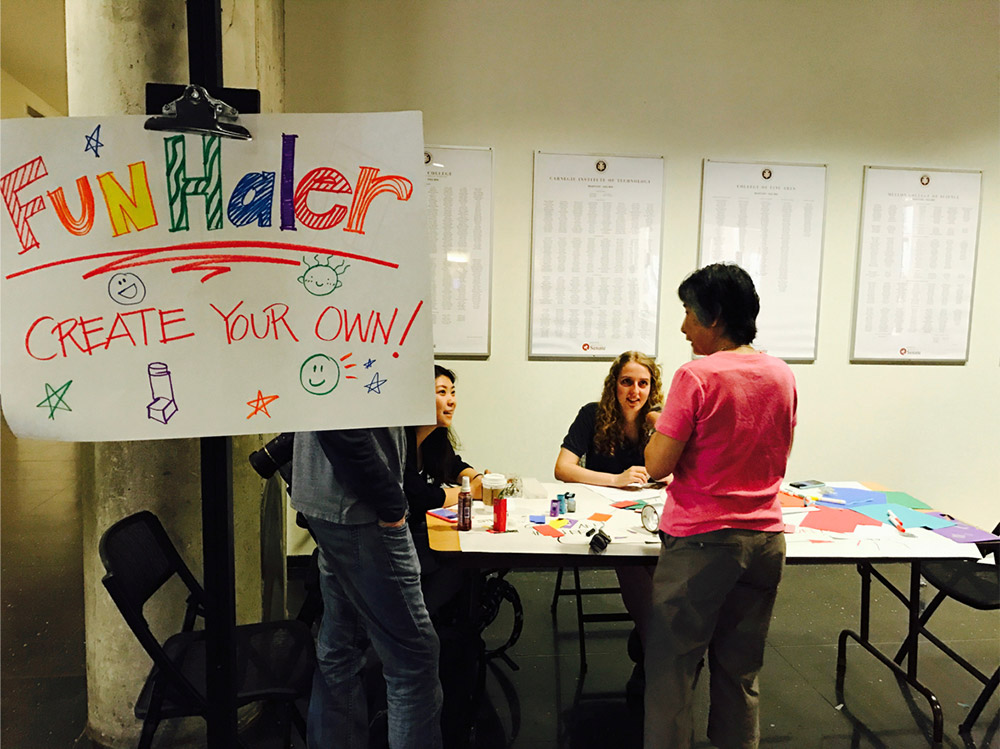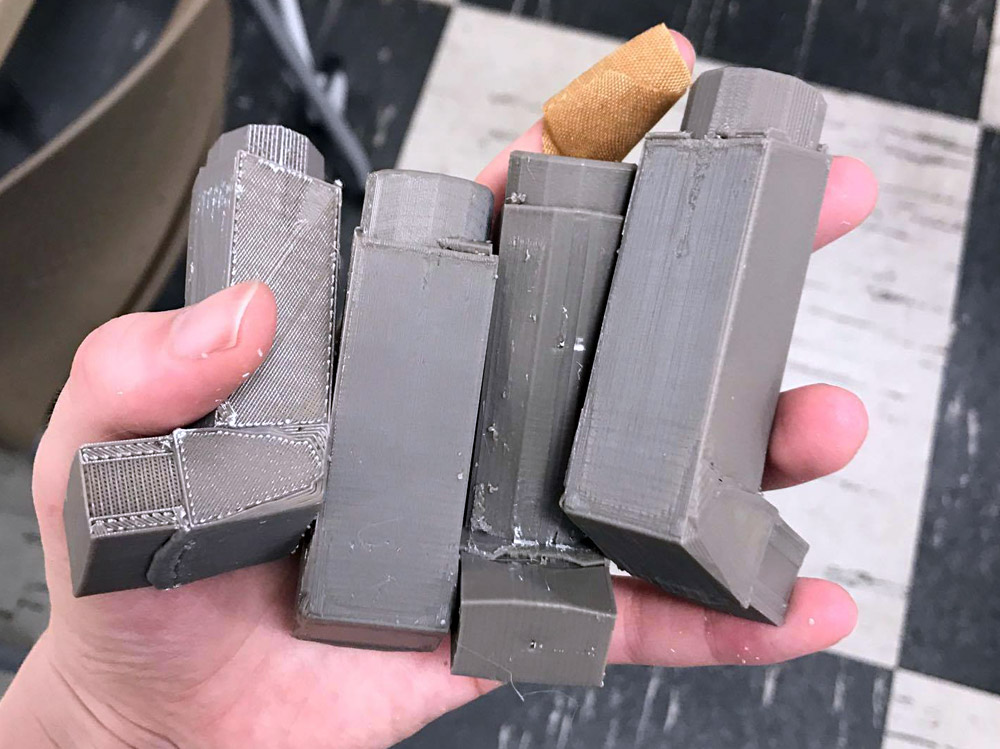UI/UX/Product Designer

Creating the Funhaler Experience
A service that enables children and their families to customize inhalers in order to de-stigmatize asthma.
Overview
How may we address the emotional and social side effects that children living with asthma endure, and how can we encourage their transition from parental management to self management?
The Funhaler is a web service that enables children and their families to customize and order their own inhalers. We hope that our approach will help to de-stigmatize asthma through better awareness and acceptance among a child and his or her peers.
Role
Collaborated with team for concept design, UI designs, research, and all project milestones
Team
Caroline Hermans, Adena Lin, Adella Guo, Jesse Wilson, and Joy Xioanan
Duration
6 months (Semester long project for Service Design course)
Award: Top 6 Student Service Design Projects at the SDN U.S. National Conference.
The Problem Space
Asthma affects 1 out of 10 children in the United States.
In addition to the physical symptoms such as difficulty breathing, asthmatic children experience many other social and emotional issues such as missing school and not being able to participate in physical activities with their friends and peers. That only adds to the challenges that children – and by extension – other stakeholders such as parents and teachers face.
How can we help to destigmatize asthma for children?
We set out to design a solution for our client, Philips, that can support children (4–10 years old) in the transition from parental to self-management.
Exploratory Research
Our first step was to learn more about asthma through secondary research. We identified several major categories that we wanted to investigate: social and emotional support, medical support, assisting caregivers, in-school support, and identifying triggers and their related management.
Stakeholders
Next, we needed to determine who our stakeholders are so we could begin speaking to them. We brainstormed who children might interact with on a daily basis, who they would encounter during their medical procedures, and also what type of people play a role in dictating policy that may affect children with asthma.
As shown in the map below, stakeholders can be grouped within several territories. The larger territories included the home, schools, doctor’s offices, extracurricular activities (such as camp and sports) and those policy makers who have no direct contact with children, but affect them nonetheless.
Interviews
We wanted to interview as many stakeholders as possible in order to build our understanding of the problem space.
To start off, the members of our team talked to friends and family members who are teachers, parents of asthmatic children, or suffer from asthma themselves to get a better understanding of where we should start.
In the weeks that followed, we conducted 14 interviews and those conversations allowed to refine our preconceptions and gain a better understanding of what children with asthma need. For instance, we listened to what teachers did when a child had an asthma attack in the classroom. We asked how parents soothed their children. We learned a lot in this process and it definitely shaped our direction moving forward.
Our Proposals
Through exploratory research and the first round of stakeholder interviews, our team identified five areas in which we could propose directions.
- School Consulting: Provide education for school teachers and administrators to better understand the issues that asthmatic children may be experiencing
- Social Support in Schools: Transform the perception of asthma to help promote inclusive behavior among children
- Emotional Support: Provide peace of mind for parents and normalize asthma for children with a customizable inhaler
- Medical Test Kit: Improve data tracking to assist diagnoses and prescriptions
- Communication: Improve communication channels between the child, parents, their school, and doctor(s)
We developed several options and strong ideas and took a step back to examine each of them. Which potential direction might provide the best benefits to children?
It ended up coming down to a vote among the team!

Our Solution
Our group chose our 3rd option, affectionately referred to as the “fun inhaler” which became the Funhaler.
What excited us most about this prospect was the potential to alter the symbology of the inhaler so that it could become something more positive and empowering for asthmatic children.
Funhaler: A UX and service design experiment aimed at destigmatizing asthma by allowing children and their parents and guardians to customize and order a unique inhaler online.
What can happen when an inhaler becomes an image of empowerment instead of one of shame?
Journey Map
After talking to our stakeholders, we now had a much better understanding of what it would be like for a child to be diagnosed with asthma. We put together a journey map visualizing this information detailing the ups and downs that a child with asthma may experience. We also examine the touch points the child may face with various stakeholders, as well as current breakdowns and opportunities.
Service Blueprint
How would our concept actually work? We looked at how some of the behind the scenes processes would function and mapped it out. From informing the customer of our service, to creating and shipping the finished Funhaler, a lot needs to happen!
Understanding Health Insurance
We recognized that health insurance is one of the most important and intricate components involved with our service. It is also one of the last pliable. A doctor we interviewed cautioned us that “it may be more trouble than it’s worth to pursue a project that involves dealing health insurance.” She went on to suggest that we alter our project to avoid insurance entirely.
While we understood her perspective, we didn’t want to compromise on the integrity of our ideas, at least not without further investigation.
Our team examined the traditional in-person pharmacy experience and sought to understand how it could be successfully be implemented online. We looked at how the eyeglasses company, Warby Paker handled insurance and prescriptions and aimed to understand if their model could serve as inspiration to us.
In the end, we decided to adopt a model similar to that of Warby Parker. (as shown in red post-its below)

“Is it Fun?”
Now that we had a strong idea of how some of the crucial service components of this project could function, we had yet to answer a big question, “would people enjoy it?”
With some blank, 3D-printed inhalers, markers, glue, construction paper, and scissors we designed a simple “decorate your own” workshop to find out!
Would people stop at our table to create a design for an inhaler? Would they enjoy it? Would it make a difference? The answer was… a resounding YES!
We were blown away by the enthusiasm and the creativity that people brought to this workshop. One personal highlight for our team was when a girl asked us if she could decorate her actual inhaler.
The Website Component
With the service side of our project all planned out, the we built out the website and user experience. We asked ourselves how the Funhaler website could be useful to families on a regular basis? We wanted it to be more than a place someone will when they are ready for their next inhaler.
Our research pointed to the inclusion of several useful features such as:
- A diary/blog that could be updated as often as the users wished
- A calendar function that keeps track of prescriptions and provides estimates of when a new order will be needed.
User Journey Map
We created a user flow that focused on exploring ways in which the website could implement these ideas.
Goals of the Website
The next steps involved developing and polishing the user interface. We were going for a clean yet playful interface that:
- Directs users to design a Funhaler. After the a design is created, the user will be prompted to log in or register a new account to save their designs and begin entering in their prescription information.
- Connects our users back to the their dashboard. This section of the website includes options for users to share their inhaler design(s), view a calendar with information about their prescriptions, to create entries in a diary or blog, and to configure email notification settings.

Website Mockups
What’s Next
There are so many potential directions this project could continue to move in.
A few of our remaining ideas and things we would seek to do next would be:
- Creating a mobile/tablet app. Currently this is solely a web-based experience.
- Expand the customizable options for the Funhaler. How could we expand our offerings beyond colors and patterns? How sophisticated of a design playground should this become? Kids also love superheroes. It would be great to explore ways of licensing recognizable characters.
- Explore rewards for frequent diary/blog entries. A gold star perhaps?
- Dive into email options. What role can email reminders and alerts play? How often should email “reminders” be sent to encourage return visits? We like the idea of allowing users to specify the intervals (daily, weekly, monthly) for the reminders. Alerts could also inform users when prescriptions may need to be refilled.
- Sharing data. Entering data and keeping a journal of a child’s asthma condition is all well and good, but how can that be shared with other stakeholders such as a doctor. Or what if a parent simply wants to print out their entries? We would look into ways of exporting this data, and/or to create an attractive, print-friendly screen.
- Explore ways to foster a better sense of community. How might users connect with, interact with, and support each other? Would a news feed of (shared) diary entries enrich the experience, or would it make this seem like another Facebook? How could we make our service and web platform stand on its own?
Final Thoughts & Conclusions
We were all immensely proud of our concept and received great feedback from our instructors, peers, and representatives from Philips.
We recognize that there are some unanswered questions dealing with health insurance and the actual production of the inhalers. How can this process be made as simple and painless as possible for families? It is extremely important to us that this benefit children everywhere, regardless of their families income, class, or education.
It comes back to the simple fact that children are children, and they shouldn’t be excluded, bullied or feel shame over something they can’t control. If the inhaler can become something positive, the goals of this project will have been accomplished.




















